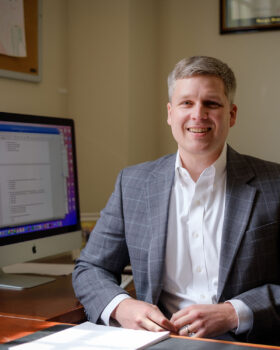Who wins and who loses in the transition from ‘dirty’ to ‘clean’ jobs?
Research looks at what the move to clean energy may mean for labor markets

New research by Wake Forest Associate Professor of Economics Mark Curtis looks at the implications for U.S. workers in the transition to a low-carbon economy.

Mark Curtis
The paper, “Workers and the Green-Energy Transition,” looks at carbon-intensive industry workers and the transition to green jobs. Curtis and co-authors R. Jisung Park, an assistant economics professor at the University of Pennsylvania, and Layla O’Kane a senior economist with the data analytics group Lightcast, analyzed data on 130 million U.S. workers and their 300 million unique job transitions.
Using workers’ job titles, company names and industries, the study first identifies green or “clean energy” jobs as jobs in solar, wind, renewables and electric vehicle manufacturing. It also identifies carbon-intensive or “dirty” jobs as those in fossil fuel sectors. It then examines the transitions that workers make away from dirty jobs and the transitions that workers make into “clean energy” jobs.
When it comes to shifting from dirty to green jobs the research findings show:
- The number of workers moving directly from a dirty to a green job has dramatically grown in recent years, increasing ten-fold since 2005.
- Younger workers are far more likely to transition from a dirty to a green job and approximately 25% of green jobs appear to be taken by first-time job-holders.
- Nonetheless, since 2020 only about 1% of all workers who left a dirty job transitioned to a green job.
- Workers in “dirty jobs” are far more likely to transition to another dirty job than a “green job.” In certain cities like Oklahoma City, Denver and Houston, more than half of the transitions away from a dirty job are into another dirty job.
These findings add to the growing body of research on green jobs and the labor market consequences of environmental policies.
“As green jobs continue to grow, we should expect an increasing number of workers in dirty jobs will move to green jobs,” said Curtis. “However, workers without a college degree and older workers are significantly more likely to remain in carbon-intensive jobs. There also may be limits to the extent that local labor markets can absorb the workers who will be displaced by the shift away from fossil fuels.”
The results suggest that Electric Vehicle (EV) and manufacturing jobs are an important source of employment opportunities for dirty workers. By 2021, half of dirty-to-green job transitions were into the EV / EV battery sector. Of workers leaving dirty jobs, approximately 30% go into manufacturing. The prevalence of dirty-to-dirty transitions in some areas of the country provides a guide to policymakers looking to identify areas of the country most at risk from the green energy transition.
Categories: Top Stories
Wake Forest News
336.758.5237
media@wfu.edu
Meet the News Team
Wake Forest in the News
Wake Forest regularly appears in media outlets around the world.




